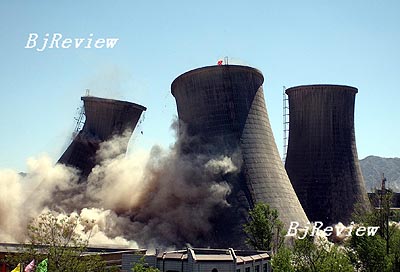|

Low energy efficiency has long plagued the industrial production of China and costs the country over half of its total energy supply.
Engines and electric machinery, widely used in industrial lines, consume 65 percent of the industrial energy. Electric machinery demands an annual energy supply of 80 billion-100 billion kwh to support its over 500-million-kw production capability, thus consuming 60 percent of its energy total, or 75 percent of that used in industry. The production of electric ring blowers and electric motor pumps amounts to 250 million kw, 70 percent of which are supposed to be backed by transmission motor drives. However, only 20 percent employ transmission motor drives, thus giving rise to a huge waste of energy.
To ease the energy tension and improve energy management ability, the Chinese Government has dedicated itself to pushing for high efficiency over the past 15 years. In the meantime, Chinese enterprises have taken actions in response, with the aluminum industry as a pioneer.
Aluminum Corporation of China Ltd. (CHINALCO) is the biggest nonferrous metal enterprise of China, the world’s second largest alumina producer and the largest Asian aluminum processor. It has attached importance to emission reductions and energy conservation for the development of enterprises and the whole country for the past six years.
China is relatively poor in bauxite resources, the reserved deposit of which stands at 532 million tons, merely 2.3 percent of the world’s total. The per-capita bauxite of China only equals 10 percent of the world average due to a large population. Of this, 90 percent of the Chinese bauxites are high aluminum, high silicon, low iron and other non-dissolvable mid-low-grade ores, in which the available ores weigh no more than 200 billion tons. It is therefore imperative to adopt the strategy of emission reduction and energy conservation for the mining, smelting and processing enterprises in the aluminum industrial chain.
Over the past six years, a package of scientific research projects focusing on emission reduction and energy conservation have been implanted thanks to the investment of more than 4 billion yuan ($533 million) by the company.
To make full use of the non-dissolvable mid-low-grade alumina, CHINALCO has developed the “ore dressing Bayer process” technology in alumina production, raising the alumina-silicon ratio of the ores from 5.6 to 11-12. The new technology has enabled CHINALCO to use over 200 million tons of mid-low-grade ores, hence tapping a new space for using of bauxite and prolonging the service life of mines by three times.
Besides this, CHINALCO has greatly lowered its energy consumption by applying a series of high technologies, including the golden medal winner of the eighth China Patent Award-an intensified sintering process for alumina production. This new technology can reduce the energy consumption by 41.7 percent, lift the recovery rate by 6 percent and cut red mud emissions by 40 percent. CHINALCO has also tightened investments to optimize wastewater treatment, enhance the recycling rate of industrial water and rein in the utilization of fresh water. At present, 80 percent of China’s alumina producers have met the zero-emission target for industrial wastewater.
In regard to electrolytic aluminum, CHINALCO has succeeded in developing and promoting new technologies shrinking energy consumption and the discharge of hazardous waste, especially in improving the service life of electrolysis. All newly established aluminum plants of China have adopted the prebaked cell series developed by CHINALCO, approaching the level of the world’s most advanced technologies. Chinese facilities and technologies of electrolytic aluminum have gained a share in the international market, realizing exports to India, Kazakhstan, Iran and Iceland.
When commenting on CHINALCO’s embarking on the path of emission reduction and energy conservation, Xiao Yaqing, General Manager of CHINALCO said persistent pursuit of emission reduction and energy conservation is of great significance for the raw material industry. In recent six years, CHINALCO has conserved 3.05 million tons of standard coal, equal to the annual production of two medium-sized coal mines, over 55.9 million tons of water and more than 1billion kwh power.
CHINALCO will carry forward the task of emission reduction and energy conservation, putting in place 117 energy-saving projects and injecting 31.74 billion yuan ($4.232 billion) in the next five years. By 2010 the energy consumption per unit of GDP of China will be cut by 20 percent, with standard coal consumption per 10,000 of GDP down to 0.98 ton, added Xiao.
Other large enterprises in China are also riding the wave of the energy conservation drive. China Huaneng Group saw its coal consumption electricity supply dipping to 344.87 g/kwh in 2006, even lower than the national average of 21 grams. The comprehensive energy consumption per ton of steel of 734.14 kg of standard coal pushed Baoshan Iron and Steel Co. Ltd. to a leading position in the world.
More importantly, these top-notch enterprises have benefited society with the addition of energy-friendly technologies, facilities, products and services. Wang Xi, Deputy Director of the Performance Examination Bureau of the State-Owned Assets Supervision and Administration Commission of the State Council cited the supercritical and ultra-supercritical power plant units co-produced by China Dongfang Electric Corporation and Harbin Power Equipment Company Ltd. as an example. These units can be powered at a coal consumption rate of electric supply below 300 g/kwh. Thus 30 million kw in production of these units of 2007 can save 10 million tons of standard coal, in comparison with the national coal consumption of electricity supply of 366 grams.
|
.jpg)
.jpg)